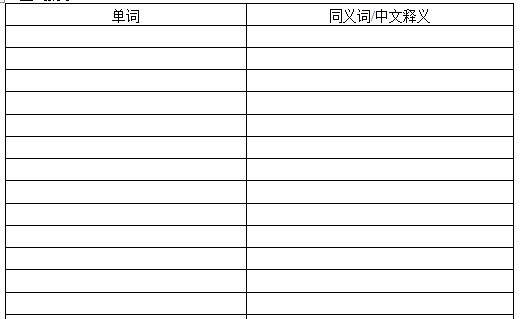摘要:新托福阅读能力是考试主办方重点考察的方向之一。除了在托福阅读部分考察外,在其他单项中也会出题考察。因此这需要考生们学习更多实用技巧来应对考试的挑战,大家在平时一定要多加练习,在下文中小编整理了托福阅读常考话题:冰川及练习题,一起来看看吧!
Passage 3
Discovering the Ice Ages
In the middle of the nineteenth century, Louis Agassiz, one of the first scientists to study glaciers, immigrated to the United States from Switzerland and became a professor at Harvard University, where he continued his studies in geology and other sciences. For his research, Agassiz visited many places in the northern parts of Europe and North America, from the mountains of Scandinavia and New England to the rolling hills of the American Midwest. In all these diverse regions, Agassiz saw signs of glacial erosion and sedimentation. In flat plains country, he saw moraines (accumulations of earth and loose rock that form at the edges of glaciers) that reminded him of the terminal moraines found at the end of valley glaciers in the Alps. The heterogeneous material of the drift (sand, clay, and rocks deposited there) convinced him of its glacial origin.
The areas covered by this material were so vast that the ice that deposited it must have been a continental glacier larger than Greenland or Antarctica. Eventually, Agassiz and others convinced geologists and the general public that a great continental glaciation had extended the polar ice caps far into regions that now enjoy temperate climates. For the first time, people began to talk about ice ages. It was also apparent that the glaciation occurred in the relatively recent past because the drift was soft, like freshly deposited sediment. We now know the age of the glaciation accurately from radiometric dating of the carbon-14 in logs buried in the drift. The drift of the last glaciation was deposited during one of the most recent epochs of geologic time, the Pleistocene, which lasted from 1.8 million to 10,000 years ago. Along the east coast of the United States, the southernmost advance of this ice is recorded by the enormous sand and drift deposits of the terminal moraines that form Long Island and Cape Cod.
It soon became clear that there were multiple glacial ages during the Pleistocene, with warmer interglacial intervals between them. As geologists mapped glacial deposits in the late nineteenth century, they became aware that there were several layers of drift, the lower ones corresponding to earlier ice ages. Between the older layers of glacial material were well-developed soils containing fossils of warm-climate plants. These soils were evidence that the glaciers retreated as the climate warmed. By the early part of the twentieth century, scientists believed that four distinct glaciations had affected North America and Europe during the Pleistocene epoch.
This idea was modified in the late twentieth century, when geologists and oceanographers examining oceanic sediment found fossil evidence of warming and cooling of the oceans. Ocean sediments presented a much more complete geologic record of the Pleistocene than continental glacial deposits did. The fossils buried in Pleistocene and earlier ocean sediments were of foraminifera—small, single-celled marine organisms that secrete shells of calcium carbonate, or calcite. These shells differ in their proportion of ordinary oxygen (oxygen-16) and the heavy oxygen isotope (oxygen-18). The ratio of oxygen-16 to oxygen-18 found in the calcite of a foraminifer's shell depends on the temperature of the water in which the organism lived. Different ratios in the shells preserved in various layers of sediment reveal the temperature changes in the oceans during the Pleistocene epoch.
Isotopic analysis of shells allowed geologists to measure another glacial effect. They could trace the growth and shrinkage of continental glaciers, even in parts of the ocean where there may have been no great change in temperature—around the equator, for example. The oxygen isotope ratio of the ocean changes as a great deal of water is withdrawn from it by evaporation and is precipitated as snow to form glacial ice. During glaciations, the lighter oxygen-16 has a greater tendency to evaporate from the ocean surface than the heavier oxygen-18 does. Thus, more of the heavy isotope is left behind in the ocean and absorbed by marine organisms. From this analysis of marine sediments, geologists have learned that there were many shorter, more regular cycles of glaciation and deglaciation than geologists had recognized from the glacial drift of the continents alone.
【段落主旨】
Paragraph 1:
Paragraph 2:
Paragraph 3:
Paragraph 4:
Paragraph 5:
【生词摘录】

索取“完整内容+练习题”,请加新航道上海老师微信(shnc_2018)

免费领取最新剑桥雅思、TPO、SAT真题、百人留学备考群,名师答疑,助教监督,分享最新资讯,领取独家资料。
方法1:扫码添加新航道老师

微信号:shnc_2018
方法2:留下表单信息,老师会及时与您联系
| 课程名称 | 班级人数 | 课时 | 学费 | 报名 |
|---|---|---|---|---|
| 托福入门段(A段)6-10人走读班 | 6-10人 | 80课时 | ¥15800 | 在线咨询 |
| 托福强化段(C段)6-10人班 | 6-10人 | 96课时 | ¥30800 | 在线咨询 |
| 托福全程段(A+B+C段)6-10人班 | 6-10人 | 224课时 | ¥55800 | 在线咨询 |
| 托福特训班(4周,走读) | 8-10人 | 192 | ¥34800 | 在线咨询 |
| 托福特训班(6周,走读) | 8-10人 | 288 | ¥49800 | 在线咨询 |
| 课程名称 | 班级人数 | 课时 | 学费 | 报名 |
|---|---|---|---|---|
| 托福精讲段(B段)20-30人班 | 20-30人 | 96课时 | ¥7800 | 在线咨询 |
| 托福强化段(C段)20-30人班 | 20-30人 | 96课时 | ¥8800 | 在线咨询 |
| 托福全程段(A+B+C段)20-30人班 | 20-30人 | 192课时 | ¥13800 | 在线咨询 |
| 课程名称 | 班级人数 | 课时 | 学费 | 报名 |
|---|---|---|---|---|
| 托福入门段(A段)(6-10人,住宿) | 6-10人 | 80课时 | ¥17800 | 在线咨询 |
| 托福强化段(C段)6-10人班住宿 | 152课时 | ¥33800 | 在线咨询 | |
| 托福全程班(A+B+C段)6-10人班住宿 | 6-10人 | 304课时 | ¥60800 | 在线咨询 |
| 托福长线班(6-10人,住宿) | 6-10人 | 272课时 | ¥77800 | 在线咨询 |
| 托福词汇语法住宿班(A段)(6-10人) | 6-10人 | 48课时 | ¥8800 | 在线咨询 |
| 课程名称 | 班级人数 | 课时 | 学费 | 报名 |
|---|---|---|---|---|
| 托福全程段(A+B+C段)20-30人班住宿 | 20-30人 | 192课时 | ¥15800 | 在线咨询 |
| 托福强化段(C段)20-30人班住宿 | 20-30人 | 96课时 | ¥8800 | 在线咨询 |
| 托福精讲段(B段)20-30人班住宿 | 20-30人 | 96课时 | ¥9800 | 在线咨询 |
| 课程名称 | 班级人数 | 课时 | 学费 | 报名 |
|---|---|---|---|---|
| 托福一对一 | 1 | 按需定制 | ¥980元 | 在线咨询 |
| 托福免费试听课 | ¥0元 | 在线咨询 |
| 课程名称 | 班级人数 | 课时 | 学费 | 报名 |
|---|---|---|---|---|
| 小托福考试技巧进阶课程 | 30 | ¥9800 | 在线咨询 | |
| 小托福精讲班 | 3-8人 | 96小时 | ¥20800 | 在线咨询 |
| 小托福强化班 | 3-8人 | 100H | ¥20800 | 在线咨询 |
免责声明
1、如转载本网原创文章,请表明出处;
2、本网转载媒体稿件旨在传播更多有益信息,并不代表同意该观点,本网不承担稿件侵权行为的连带责任;
3、如本网转载稿、资料分享涉及版权等问题,请作者见稿后速与新航道联系(电话:021-64380066),我们会第一时间删除。
地址:徐汇区文定路209号宝地文定商务中心1楼
乘车路线:地铁1/4号线上海体育馆、3/9号线宜山路站、11号线上海游泳馆站
总部地址:北京市海淀区中关村大街28-1号6层601 集团客服电话:400-097-9266 总部:北京新航道教育文化发展有限责任公司
Copyright © www.xhd.cn All Rights Reserved 京ICP备05069206


 微信公众号
微信公众号
 微信社群
微信社群